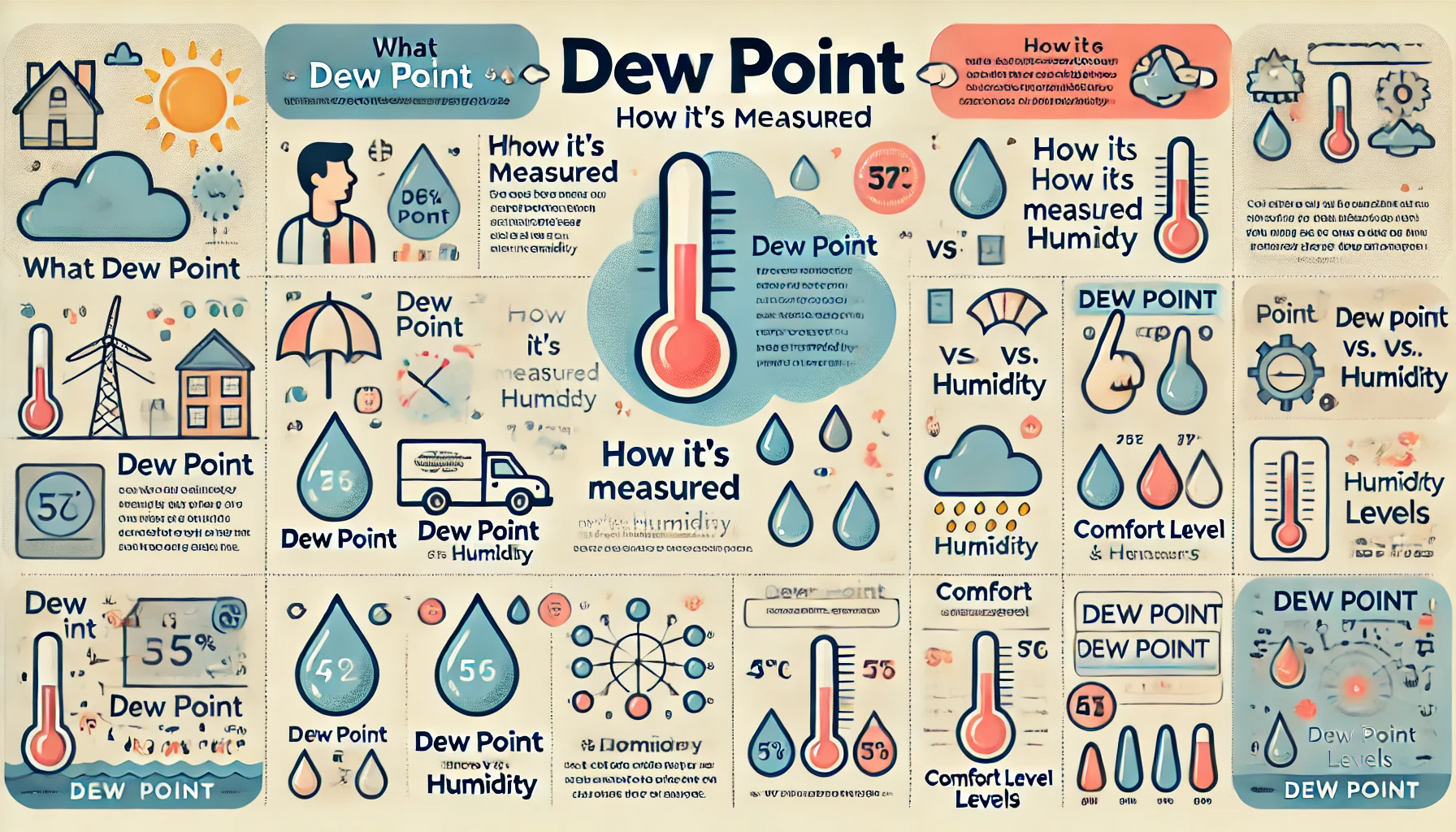What is Dew Point? Understanding This Essential Weather Term | Discoveringly
At Discoveringly, we believe that understanding weather elements can greatly enhance our daily lives, from predicting rain and humidity to enjoying outdoor activities comfortably. One key weather term that often comes up is the dew point. It’s a vital measure that helps us understand how humid and “sticky” the air feels, but it’s often misunderstood. In this blog, we’ll explain what the dew point is, how it’s measured, and why it matters in everything from weather forecasts to daily comfort.
1. What is Dew Point?
The dew point is the temperature at which the air becomes fully saturated with water vapor, meaning it cannot hold any more moisture. When the air cools to this temperature, water vapor condenses into liquid water, forming dew, frost, or even fog. This temperature tells us not only when condensation will occur but also how humid the air feels.
Key Points About Dew Point:
- Humidity Indicator: The higher the dew point, the more humid the air feels.
- Constant Temperature: The dew point remains the same regardless of air temperature, as long as the amount of moisture in the air stays constant.
- Comfort Measure: Unlike relative humidity, which varies with temperature, the dew point provides a more consistent measure of comfort and moisture levels in the air.
2. How is Dew Point Measured?
Dew point is measured in degrees (Celsius or Fahrenheit) and is typically determined using a hygrometer or a psychrometer. These instruments measure humidity levels, allowing meteorologists to calculate the dew point based on the current temperature and moisture content.
Calculation Basics:
While advanced instruments can measure dew point directly, it can also be calculated using temperature and relative humidity. The calculation involves complex formulas based on atmospheric pressure and vapor pressure, making it primarily used by professionals in meteorology.
3. Dew Point vs. Humidity
Many people confuse dew point with relative humidity, but they’re quite different. Here’s a quick breakdown:
- Relative Humidity: Expressed as a percentage, relative humidity measures the amount of moisture in the air relative to the maximum moisture the air can hold at a given temperature. It varies with changes in temperature.
- Dew Point: Measures the actual amount of moisture in the air and indicates the temperature at which the air becomes fully saturated, leading to condensation. It remains constant unless moisture levels change.
Why Dew Point is a Better Comfort Indicator
Since dew point measures the actual amount of moisture in the air, it provides a clearer sense of how the air feels. For example, a 70°F dew point feels humid regardless of the current temperature, whereas relative humidity changes as the temperature fluctuates, often making it a less reliable comfort indicator.
4. What Do Different Dew Point Levels Mean?
Dew point values can vary widely depending on location, season, and weather conditions. Here’s a guide to what different dew point levels generally indicate:
- Below 50°F (10°C): Dry and comfortable. This range is often found in desert climates and feels refreshing, especially during cooler seasons.
- 50°F to 60°F (10°C to 16°C): Moderately humid but still comfortable. Many people feel at ease in this range, making it ideal for outdoor activities.
- 60°F to 70°F (16°C to 21°C): Noticeably humid. The air starts feeling “sticky,” and physical exertion may feel slightly uncomfortable.
- Above 70°F (21°C): Very humid and often uncomfortable. High dew points in this range make the air feel oppressive and can increase the risk of heat-related illnesses in extreme cases.
5. Why Does Dew Point Matter?
Dew point has practical applications in both weather prediction and daily life. Here’s why it matters:
Weather Forecasting
Dew point is critical in predicting precipitation, fog, and frost. When the temperature falls to the dew point at ground level, dew forms. If it’s below freezing, frost develops. Additionally, high dew points often signal upcoming storms or rainfall, as moist air is more likely to condense and create precipitation.
Comfort and Health
High dew points can make the air feel extremely humid, which can impact our comfort and even health. When the dew point rises, the body’s ability to cool down through sweating decreases. This can lead to overheating, especially in high temperatures, potentially causing dehydration or heat-related illnesses.
Agriculture and Gardening
Dew point plays a crucial role in agriculture, where understanding moisture levels is essential for crop growth. High humidity levels can lead to fungal diseases in plants, while low moisture can cause dehydration in crops.
6. How to Use Dew Point Information in Daily Life
Understanding dew point can help you plan for a comfortable and safe day, whether you’re exercising outdoors, managing indoor climate, or planning a day out:
- Outdoor Activities: A lower dew point (below 60°F) is ideal for running, hiking, and other physical activities. High dew points make it harder to stay cool and may require taking more breaks or staying hydrated.
- Home Comfort: For indoor comfort, a lower dew point can reduce humidity, making your home feel cooler. During hot, humid days, using a dehumidifier can help manage high indoor moisture levels.
- Travel Plans: If you’re heading to a tropical or humid climate, knowing the dew point can help you anticipate the weather and pack appropriately for comfort.
7. The Science Behind Dew Point Formation
The process behind dew point formation is a combination of temperature, air pressure, and moisture content:
- Condensation Process: When warm, moist air cools to the dew point, it reaches saturation. The water vapor in the air then begins to condense into tiny droplets, forming dew.
- Temperature and Altitude: Dew point can vary based on altitude and temperature. For instance, dew forms more readily in low-lying areas like valleys where cool air can settle.
- Nighttime Cooling: Dew is most likely to form overnight when temperatures drop. As the ground cools, the air near it also cools, often reaching the dew point by early morning.
8. Dew Point in Extreme Weather
Dew point measurements are especially important in extreme weather conditions:
- Heatwaves: High dew points during a heatwave can increase the discomfort level and the risk of heatstroke, as the body struggles to cool down.
- Cold Weather: In cold climates, a low dew point can lead to frost or even ice formation when temperatures drop below freezing, impacting travel and outdoor activities.
9. Conclusion
At Discoveringly, we’re passionate about helping you understand complex weather elements that impact your day-to-day life. The dew point is more than just a number on a weather forecast—it’s a key factor that influences comfort, safety, and planning. Whether you’re planning outdoor activities, adjusting your indoor environment, or simply curious about how weather works, understanding the dew point can help you make better decisions. So the next time you check the weather, don’t just look at the temperature; take a glance at the dew point to get a fuller picture of what to expect.






